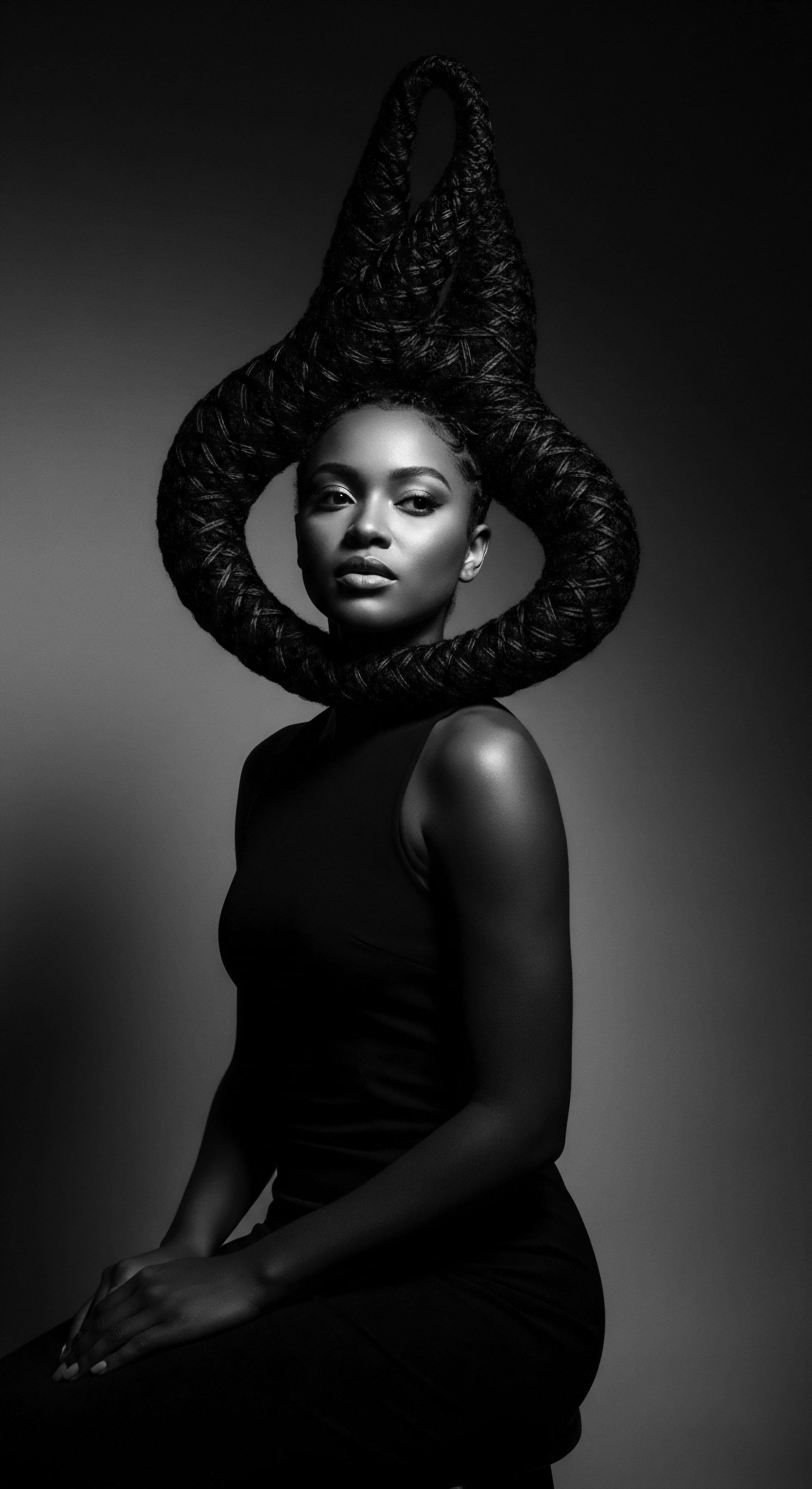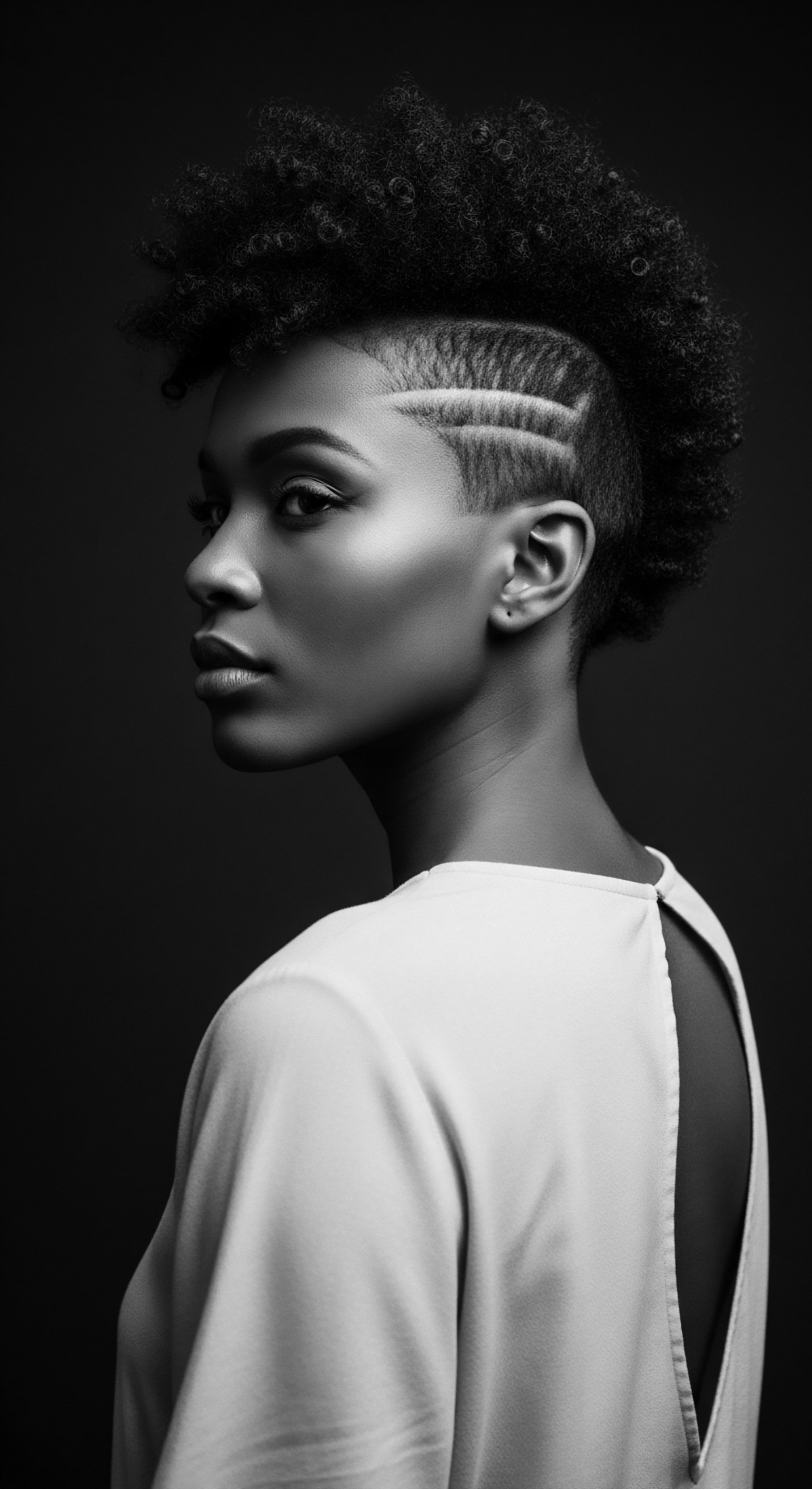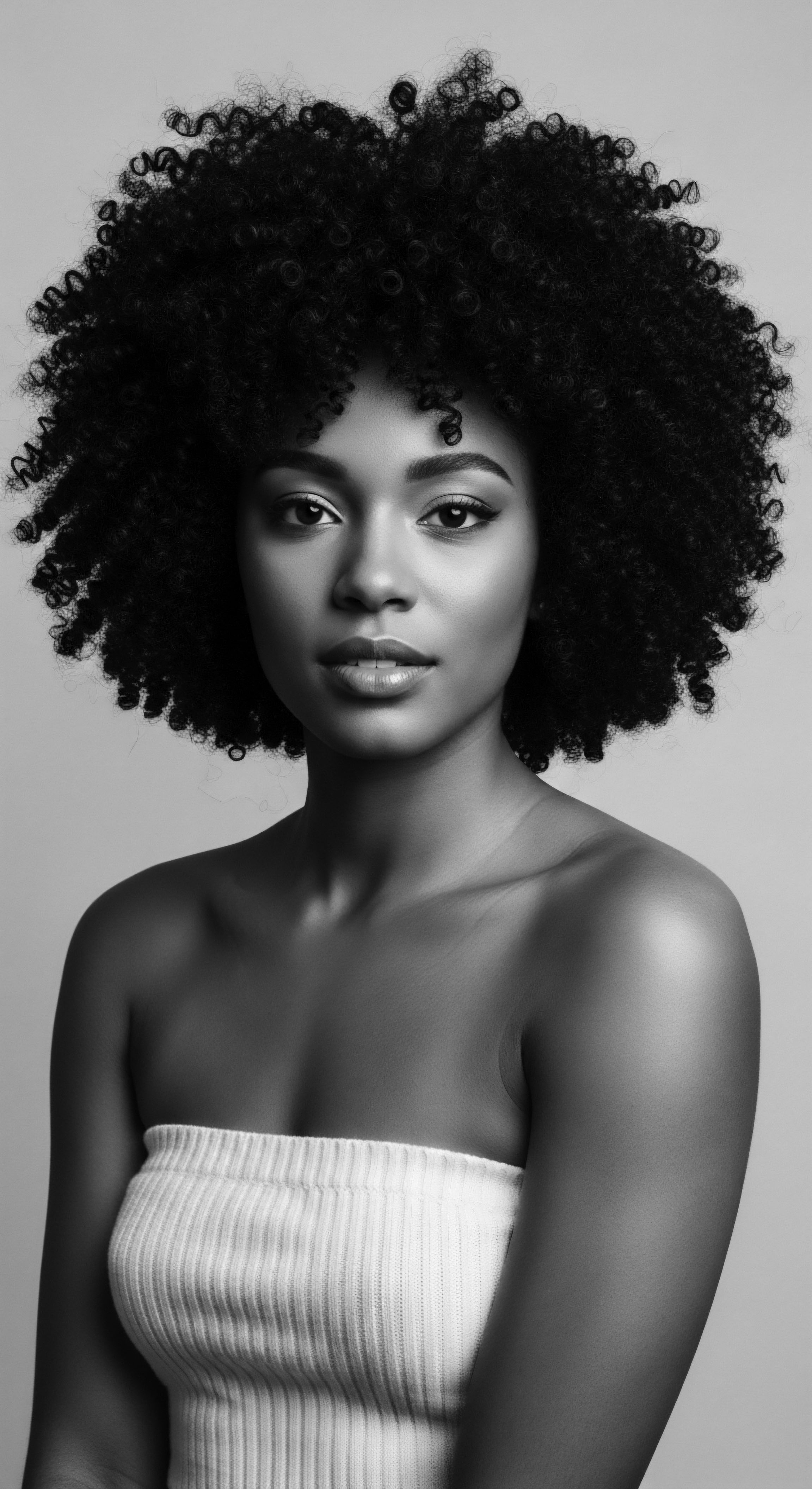
Roots
The very act of touching textured hair, of tending to its coils and waves, is a dialogue with generations past. It is not a simple matter of hygiene, a mere functional task; it holds a deeper resonance. For centuries, across continents and through the tides of time, the care of textured hair has been a language spoken through hands, a narrative carried in each strand.
Its significance extends beyond outward presentation, reaching into the profound wellspring of identity, community, and ancestral memory. To understand the importance of cleansing such hair is to comprehend a legacy, a living archive of resilience and beauty.
This is a journey into the elemental biology of hair and the ancient practices that shaped its care, echoing wisdom from the source. The hair strand itself, particularly a textured one, presents a unique architecture. Its elliptical cross-section and curl pattern mean more bends, more turns, making it prone to dryness and tangling. This inherent structure means that naturally occurring scalp oils, sebum, struggle to travel down the shaft, leaving the ends particularly vulnerable.
Cleansing, then, becomes a delicate balance ❉ removing buildup and environmental impurities without stripping the precious moisture that is textured hair’s constant companion. The wisdom of early civilizations instinctively grasped this equilibrium.

Cleansing Practices Across Ancient Lands
Consider the Himba people of Namibia. For them, hair is not merely an aesthetic concern. It is a vital part of their cultural identity, social status, and spiritual connection. The Himba women practice a meticulous cleansing and adornment ritual involving Otjize, a paste of butterfat, ochre, and aromatic resin.
This mixture serves as both a protective layer against the harsh sun and a cleansing agent, gently purifying the hair and scalp while infusing it with moisture and vibrant color. This practice is not about a quick wash; it is a daily, intentional layering of care that respects the hair’s inherent needs and its symbolic weight.
Across other ancient African communities, the approach to hair washing was similarly intertwined with holistic wellbeing and spiritual practice. Rhassoul clay, derived from the Arabic word ‘ghassala,’ meaning “to wash,” was utilized in North Africa for centuries, prized for its ability to draw out impurities without stripping natural oils. Similarly, African black soap, crafted from the ash of local plants like cocoa pods, palm tree leaves, and plantains, provided a deep yet gentle cleanse, leaving hair nourished with vitamins and antioxidants.
These historical cleansing rituals were not divorced from the wider ecosystem of care; they were foundational steps that prepared the hair for intricate styling, adornment, and the communal gatherings where hair work often took place. The rhythm of these practices, often communal and deeply personal, embedded the act of cleansing within the social fabric.
Cleansing textured hair is a purposeful act, acknowledging its unique biological structure while honoring centuries of ancestral practices that saw hair care as a sacred part of identity.

What is the Fundamental Structure of Textured Hair?
The unique helical shape of textured hair, from loose waves to tight coils, means that the cuticle layers do not lie as flat as in straight hair. This open structure, while giving textured hair its remarkable volume and appearance, also allows moisture to escape more readily and makes strands more susceptible to environmental aggressors and physical manipulation. The very nature of its architecture means dirt, product residue, and environmental pollutants can cling more persistently within the curves and crevices.
Proper cleansing becomes the indispensable first step to address these specific needs, allowing the hair to breathe and the scalp to remain healthy. The integrity of the hair’s structure depends on a gentle but effective removal of accumulated debris, preventing mechanical damage during subsequent detangling and styling.
The ancestral understanding of this fragility, long before modern microscopy, led to practices that prioritized lubrication and minimal manipulation during cleansing. Oils and butters were often used as pre-shampoo treatments or incorporated directly into cleansing agents to cushion the strand and ease the removal of impurities, ensuring the hair’s delicate structure was preserved. This thoughtful approach protected the hair’s natural strength, a lesson passed down through generations.

Ritual
The journey of textured hair care, particularly cleansing, evolved from these ancient roots into a living, breathing ritual, particularly within Black and mixed-race experiences. It became a tender thread connecting individuals to their heritage, a practice imbued with purpose far beyond simple cleanliness. This transition from elemental biology to an intricate communal and personal rite highlights how cleansing is deeply embedded in the narrative of textured hair styling and transformation.
For many, the concept of “wash day” is not a chore to be rushed through. It is a sacred event, often stretching for hours, involving multiple steps, and historically, a significant communal activity. Zenda Walker, author of “Know Your Hairitage ❉ Zara’s Wash Day,” describes the weekly ritual for many children of African descent, sitting by the kitchen sink as a female relative meticulously shampooed, rinsed, and combed through their hair.
This was a time of bonding, of shared stories, and of passing down knowledge. It speaks to a collective experience, a continuity of care that defied erasure, becoming an act of preservation.

How Does Cleansing Inform Styling Choices?
The way textured hair is cleansed directly influences its receptiveness to styling and its ability to maintain definition and health. Residual product buildup from gels, creams, and oils, while necessary for styling, can weigh the hair down, obscure its natural pattern, and impede moisture absorption if not properly removed. A thorough yet gentle cleanse prepares the hair, allowing curls to clump, braids to lay flat, and protective styles to last.
Without a clean canvas, even the most skilled hands cannot achieve optimal results. This understanding guided ancestral practices where cleansing was always a prelude to adornment and protective measures.
Traditional styling techniques, such as various forms of braiding and twisting, often began with a cleansed and conditioned scalp. This ensured the longevity of the style and maintained scalp health underneath.
- Pre-Washing Oils ❉ Many historical practices involved saturating hair with natural oils or butters before washing. This pre-treatment, often with ingredients like Shea Butter or Coconut Oil, helped to protect strands from excessive water absorption and friction during cleansing, minimizing potential damage and preserving moisture.
- Herbal Rinses ❉ Beyond simple water, concoctions of herbs like Amla, Hibiscus, or Reetha were used for their cleansing properties, often in conjunction with their conditioning and strengthening benefits. These rinses left hair not only clean but also pliable and prepared for styling.
- Finger Detangling ❉ The careful, sectioned approach to detangling that accompanies cleansing in many textured hair routines has roots in ancestral wisdom, where combs were often made from natural materials and used gently on wet, conditioned hair to minimize breakage.
The tools employed in hair care, from wide-toothed combs to specialized implements for braiding, were developed with the unique needs of textured hair in mind. Cleansing forms the bedrock for the effective use of these tools, allowing them to glide through softened hair, whether preparing for cornrows that mapped escape routes during enslavement or for Bantu knots symbolizing social status.
| Aspect Cleansing Agents |
| Ancestral Practices Rhassoul clay, African black soap, plant ashes, herbal infusions |
| Contemporary Relevance Sulfate-free shampoos, co-washes, clarifying cleansers |
| Aspect Moisture Retention |
| Ancestral Practices Pre-oiling, use of butters (shea, cocoa), natural humectants (honey) |
| Contemporary Relevance Deep conditioners, leave-in treatments, conditioning washes |
| Aspect Technique Focus |
| Ancestral Practices Gentle manipulation, sectioning, communal activity, ritualistic care |
| Contemporary Relevance Finger detangling, scalp massage, targeted application, mindful approach |
| Aspect The continuity of these principles demonstrates an enduring respect for textured hair's intrinsic nature. |
Even during periods of forced assimilation, such as slavery, where traditional tools and methods were stripped away, the ingenuity of those in the diaspora led to adaptive cleansing practices using what was available, like cooking oils and animal fats. This adaptability speaks volumes about the deep-seated significance of hair care, not just as a beauty standard, but as an act of cultural survival. The natural hair movement today, with its emphasis on embracing the hair’s inherent texture, directly reclaims these historical tenets, recognizing that proper cleansing is the initial step in celebrating the hair’s natural form and its lineage.

Relay
The understanding of cleansing textured hair transcends mere individual routine; it is a relay of wisdom, passed from one generation to the next, adapting through time while retaining its core principles rooted in heritage. This intergenerational transfer of knowledge forms the basis of holistic care, addressing not only the physical well-being of the hair but also its profound impact on self-perception and cultural continuity. To grasp the deeper significance of cleansing is to see it as a vital link in this ongoing chain of ancestral wisdom and contemporary science.
For women of African descent, historical studies indicate that frequent shampooing was often limited to weekly or bi-weekly intervals, a practice rooted in the hair’s tendency toward dryness. This was not a lack of hygiene, but a sophisticated, adaptive response to the hair’s specific needs, balancing cleanliness with moisture preservation. Modern dermatology now corroborates this, recommending similar frequencies to prevent excessive dryness and breakage while still addressing product buildup and scalp health concerns like seborrheic dermatitis. The continuity between ancient wisdom and current scientific understanding highlights a deeply informed approach that has always sought equilibrium between removal and replenishment.

How Does Cleansing Protect Textured Hair Health?
The unique coil and curl patterns of textured hair mean that natural oils produced by the scalp do not easily travel down the hair shaft. This leaves the ends vulnerable to dryness and breakage, requiring specific cleansing methods that avoid stripping these essential lipids. Cleansing with gentle, moisturizing formulations, or even conditioning washes, has become a cornerstone of modern textured hair care, echoing ancestral practices of using emollients to prepare and cleanse. When buildup accumulates from styling products or environmental exposure, it can block follicles, impede healthy growth, and even exacerbate scalp conditions.
A proper cleansing regimen purifies the scalp, allowing it to breathe and supporting the environment necessary for healthy hair to emerge. This foundational step is not about conforming to external standards; it is about providing the optimal conditions for each strand to flourish in its natural, inherited glory.
The ritual of cleansing extends to the very act of detangling, which often follows or is integrated into the wash process. Because textured hair can intertwine and form knots, detangling while wet and conditioned minimizes friction and breakage. This careful, sectioned approach to unraveling strands, often done with the fingers or wide-toothed tools, preserves the hair’s length and integrity, directly combating the fragility often imposed by harsh treatments or careless handling. This gentle approach safeguards the very structure that makes textured hair so distinctively beautiful and historically significant.
The products used in cleansing, whether traditional preparations or contemporary formulations, play a substantial role. Historically, ingredients were sourced directly from the earth, known for their healing and protective qualities.
- Aloe Vera ❉ Used traditionally for its soothing and moisturizing properties on the scalp and hair, contributing to a clean yet hydrated feel.
- Rooibos Tea ❉ Employed as a rinse, this South African herb possesses antimicrobial properties that promote scalp health and add shine to hair.
- Castor Oil ❉ A long-revered ingredient in many African and diasporic communities, applied as a pre-shampoo treatment to add moisture and reduce protein loss during washing, protecting the hair.
This relay of knowledge is evident in the emphasis on protective styling, a practice with ancient roots. Styles like cornrows and braids, used for thousands of years to protect hair from environmental damage and manipulation, necessitate proper cleansing to maintain scalp health and prevent issues like traction alopecia. The balance lies in effective cleaning beneath these styles without disrupting their integrity. This calls for specific techniques, often involving diluted cleansers and targeted scalp applications, a testament to the adaptive nature of cleansing within the broader care framework.

What is the Ancestral Basis for Nighttime Hair Care?
The practice of nighttime hair protection, often involving bonnets, wraps, or scarves, also holds ancestral significance. While modern science points to satin and silk’s benefits in reducing friction and moisture loss, the underlying principle of safeguarding hair during rest has a long history. In many African cultures, head wraps symbolized status, spiritual connection, and protection.
This tradition, adapted over time, underscores a continuous understanding that hair, particularly textured hair, requires dedicated care beyond the active hours of the day to maintain its health and preserve its styled state. Cleansing prepares the hair for this nightly sanctuary, ensuring it is clean and receptive to restorative treatments.
This consistent attention to cleansing, in its various forms throughout history, has enabled textured hair to serve as a powerful visual marker of identity and self-expression. From elaborate pre-colonial styles denoting tribal affiliation or marital status to the symbolic Afros of the Civil Rights movement, hair has consistently been a canvas of cultural communication. Cleansing, as the essential first step, allows this canvas to be prepared for its continuous articulation of heritage and belonging.

Reflection
The journey through the cleansing of textured hair is, at its heart, a profound meditation on heritage. It is a story told not just through the biology of each coil and curl, but through the enduring practices, the shared rituals, and the deep cultural meanings woven into every wash day. From the ancient earths and botanicals used to purify and nourish, to the communal “wash day” gatherings that fostered connection and passed down wisdom, cleansing has been more than a functional act. It has been a testament to resilience, a continuous thread connecting past to present.
This journey invites us to see textured hair as a living library, its care a practice of reading, understanding, and contributing to generations of knowledge. The ancestral approaches, born of necessity and deep observation, laid the groundwork for contemporary understanding, proving that the earliest methods often held profound scientific truths. As we continue to refine our methods and expand our understanding, we are not simply performing a routine.
We are participating in an ongoing conversation with our ancestors, honoring their ingenuity and carrying forward a legacy of self-possession and cultural pride. The cleansing of textured hair, then, becomes an act of reverence, a soulful commitment to the vitality of each strand and the rich heritage it carries.

References
- Byrd, Ayana, and Lori L. Tharps. Hair Story ❉ Untangling the Roots of Black Hair in America. St. Martin’s Griffin, 2014.
- Hooks, Bell. Black Looks ❉ Race and Representation. South End Press, 1992.
- Mercer, Kobena. Welcome to the Jungle ❉ New Positions in Black Cultural Studies. Routledge, 2017.
- Bundles, A’Lelia. On Her Own Ground ❉ The Life and Times of Madam C. J. Walker. Scribner, 2001.
- Akou, Delia. The Culture of Fashion. Berg, 2008.
